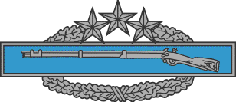Combat Infantryman Badges
First Award
Second Award
Third Award

Fourth Award
I. DESCRIPTION: A silver and enamel badge 1 inch in height and 3 inches in width, consisting of an infantry musket on a light blue bar with a silver border, on and over an elliptical oak wreath. Stars are added at the top of the wreath to indicate subsequent awards; one star for the second award, two stars for the third award and three stars for the fourth award.
II. SYMBOLISM: The bar is blue, the color associated with the Infantry branch. The musket is adapted from the Infantry insignia of branch and represents the first official U.S. shoulder arm, the 1795 model Springfield Arsenal musket. It was adopted as the official Infantry branch insignia in 1924. The oak symbolizes steadfastness, strength and loyalty.
III. AWARD ELIGIBILITY: Awarded to personnel in the grade of Colonel or below with an infantry military occupational specialty who have satisfactorily performed duty while assigned as a member of an infantry unit, brigade or smaller size, during any period subsequent to 6 December 1941 when the unit was engaged in active ground combat. The policy was expanded to permit award to Command Sergeants Major of infantry battalions or brigades, effective 1 January 1967. Specific criteria for each conflict was also established. Only one award is authorized for service in Vietnam, Laos, Dominican Republic, Korea (subsequent to 27 July 1954), Grenada, Panama, and Southwest Asia. The complete criteria for each area and inclusive dates are listed in Army Regulation 600-8-22.
IV. DATE APPROVED: The Combat Infantryman Badge was approved by the Secretary of War on 7 October 1943 and announced in War Department Circular 269 dated 27 October 1943. On 8 February 1952, the Chief of Staff, Army, approved a proposal to add stars to the Combat Infantry Badge to indicate award of the badge in separate wars. Under this change in policy, the badge was no longer limited to a one-time award, but may now be awarded to eligible individuals for each war in which they participated.
Branch Insignia: Infantry
Two gold color crossed muskets, vintage 1795 Springfield musket, 3/4 inch in height.
Crossed muskets were first introduced into the Army as the insignia of officers and enlisted men of the Infantry on 19 November 1875 (War Department General Order No. 96 dated 19 Nov 1875) to take effect on or before 1 June 1876. Numerous attempts in the earlier years were made to keep the insignia current with the ever- changing styles of rifles being introduced into the Army. However, in 1924 the branch insignia was standardized by the adoption of crossed muskets and the 1795 model Springfield Arsenal musket was adopted as the standard musket to be used. This was the first official United States shoulder arm, made in a government arsenal, with interchangeable parts, caliber .69, flint lock, smooth bore, muzzle loader. The standardized musket now in use was first suggested by Major General Charles S. Farnsworth, U.S. Army, while he was the first Chief of Infantry, in July 1921, and approved by General Pershing, Chief of Staff, in 1922. The device adopted in 1922 has been in continual use since 1924. There have been slight modifications in the size of the insignia over the years; however, the basic design has remained unchanged.
